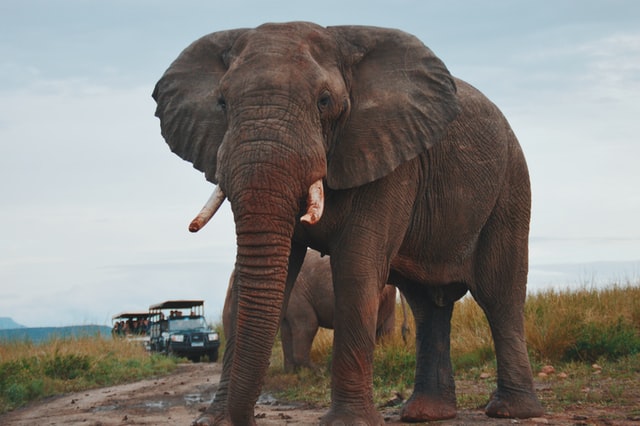Top Wild Animals in Africa – Africa Facts Africa

Seeing wild animals in Africa on a game drive is one of the most memorable moments of a safari vacation. A self-driving safari is a once-in-a-lifetime opportunity to observe these magnificent creatures in their natural habitat.
The Wild Animals in Africa
LION
There are no predators on the African plains, thus the lion is king of the roost there.
The lion, one of the wild animals in africa leads a tiny pride of these magnificent felines.
On a game drive, they are the most easily seen cat since they have no fear of other animals and no desire to conceal themselves.
Despite this, they remain one of the most intriguing species of African wildlife to come across.
Lions hunt at night and sleep during the day, hide from the sun in trees or heavy foliage, to avoid the glare of the sun.
The ideal times to get a glimpse of them are early in the morning when they are out hunting, or later in the evening when they are preparing for the night.
Also Read: African Lions Plus Facts About African Lions
The Wild Animals in Africa: LEOPARD
In the wild, leopards are notoriously hard to find. They are reclusive and spend much of their time in trees or caves.
At night, in shrubby, rocky areas with little light, hunters hunt.
Even though the number of African leopard is decreasing, they may still be seen living outside of national parks on local agriculture.
A self-drive safari’s chances of seeing a leopard are slim.
It’s a good idea to hire a guide who understands the region and has radio communication with other guides, so that you can explore more ground.
The Wild Animals in Africa: AFRICAN ELEPHANT
You won’t be able to overlook elephants, who are on the IUCN red list of endangered species, because to their enormous size.
Another indication that elephants are close is the path of destruction left behind by the elephants’ enormous trunks as they tear through the undergrowth.
Seeing a big herd of elephants on an African safari is one of the most exhilarating moments of the trip.
Keeping your distance from a lone bull when on safari is a good idea since they may be cranky and unpredictable.
During the dry season, when they congregate near waterholes to drink, it is best to see them during the day.

The Wild Animals in Africa: CROCODILES
Crocodiles, one of the wild animals in Africa are deadly and violent creatures that don’t live in any kind of group but will tolerate each other enough to swim together when eating and lounging about.
The Nile Crocodile, Africa’s most common crocodile, is an apex predator, which means it is the only animal in its food chain with no natural competitors.
Approximately 200 individuals every year are killed by crocodiles when they go too close to their territory. As a result, keeping an eye out for them from a distance is a smart move.
The Wild Animals in Africa: WHITE RHINO + BLACK RHINO
Only two female northern white rhinos remain in the world, the result of decades of widespread poaching.
Between 1960 and 1995, the number of black rhinos fell by 98 percent, although conservation efforts have led to a rebound in the population to roughly 5,600.
However, they are still listed as severely endangered by the IUCN.
There has been a true conservation success story in reviving southern white rhinos.
An estimated 100 individuals were found in KwaZulu-Natal, South Africa, near the end of the 19th century after the species had been declared extinct by the local authorities.
Estimates put the current population of the protected regions and private game reserves at roughly 20,000.
The Wild Animals in Africa: AFRICAN BUFFALO
The buffalo is Africa’s only wild cow species, and one of the wild animals in Africa.
It is the last of Africa’s Big 5 (the others being leopard, lion, elephant, and rhino).
Animals of the savannah gather in large groups to avoid being attacked by predators.
These animals congregate in big numbers around waterholes because they are habitual drinkers.
Herds of buffalo are continuously on the move, in search of new grass and water, therefore the best places to see them are in between waterholes.
Keep a look out for lions since they often track buffalos.
The Wild Animals in Africa: CHEETAH
Because of its limited number, the cheetah, the world’s fastest land mammal and one of the wild animals in africa, may be difficult to see.
However, they hunt during the day to evade bigger predators and run fast over broad grasslands to pursue their prey.
As a result, even if you happen to see one, it’s likely part of a thrilling pursuit that you’ll be able to see the whole thing through.
The cheetah is most active in the early and mid-morning hours of a safari drive.
Go to the wide-open plains where they can make the most of their speed because of the absence of vegetation.
The Wild Animals in Africa: HYENA
A wide range of habitats, including dry bushland, open plains, and rocky terrains, are hyenas’ natural habitats of choice.
To be clear: They don’t have particular food preferences, and will happily consume just about everything.
Hyenas, one of the wild animals in africa have a reputation for being predominantly scavengers, but this is untrue – they eat roughly 70 percent of their food from their own kills.
While hunting or foraging, hyenas often use their frightening laugh to communicate.
During the day, they like to relax by their den or by the lake. As soon as they wake up in the morning, it’s the optimum moment to catch them in the act.
The Wild Animals in Africa: WILD DOG
Despite their cute appearance, wild canines may be frightening due to their enormous ears, which resemble Mickey Mouse ears.
Stamina and camaraderie are their main strengths. They pursue their target until they can no longer flee, they hunt in packs and work together to exhaust them.
Spotting a wild dog is a rare and exciting event, since they are notoriously tough to track down.
Their preferred habitats are dense woodlands or wide grasslands, where they may lurk undetected for long periods of time before pouncing on their victim.
They move so quickly that even if you manage to get a glance, it won’t last long.
The Wild Animals in Africa: HIPPO
Hippos are one of Africa’s most ferocious and territorial creatures.
They have a reputation for being exceedingly protective of their young, particularly while they’re nearby.
Hippopotamuses shield their skin from the sun by frolicking in muddy pools or shallow estuaries throughout the day. But at night, they leave the water to eat grasses before returning to the water before sunrise.
Hippos may be seen in river pools at any time of day, although you’ll usually just see the tops of their heads.
If you want to get a closer look at this wonderful safari animal, a night safari affords the opportunity to observe them out of the water.

The Wild Animals in Africa: GIRAFFE
Giraffe populations in southern Africa have rebounded in recent years, after years of decline.
The increase of interest in seeing the lethargic behavior and perplexed looks of these elegant but ungainly African creatures is a good development for tourists.
It’s not hard to find a giraffe since it stands out in the crowd. At the waterhole, their uncomfortable position as they sip is a sight to see.
The Wild Animals in Africa: ZEBRA
As one of the most identifiable African animals because of its distinctive black and white stripes, the zebra has become an iconic image.
The contrast between their coloration and their surroundings makes them an excellent subject for wildlife photography.
Traveling zebras eat anything they can find, grazing on the ground as they go.
Because they congregate in huge groups known as harems, it’s easy to see them when on safari.
In every African safari park where there is water and grass, you may almost certainly locate a zebra.
The Wild Animals in Africa: KUDU
Kudu, one of the wild animals in africa is an outstanding African mammal to observe on safari, with a characteristic corkscrew horn.
Elegant with white loops wrapped around coats varying from light brown to deep chocolate, these antelopes are one of the biggest.

Kudu are usually seen in groups, however they may often be seen wandering about on their alone.
They are usually sighted hiding in the brush since they rely on the vegetation to hide from predators. If you spot one in the wild, it’s advisable to remain as quiet as possible and avoid a conflict.
The Wild Animals in Africa: WILDEBEEST
The majestic wildebeest frequently seem to be posing for pictures, with their wide-eyed expressions and boxy heads. Despite their cow-like appearance, their backs taper down to slim legs.
In pursuit of nourishing grass and water, over 2 million animals migrate across the Serengeti-Mara habitat each year during the big migration.
The migration occurs throughout the year, but the ideal time to see it is between June and September, when the weather is dry.
Also Read: The Great Migration of Africa: What, When and Where
The Wild Animals in Africa: ORYX
If you’ve ever wanted to see something grand and beautiful in the wild, look no further than the Oryx.
Their beautiful outlines against bleak and isolated surroundings may frequently be seen in the most parched parts of Africa.
In big herds of 40 or more, they are most often seen sauntering about in the middle of the day.
Due to the popularity of their horns as a lucky charm and the fact that they are sometimes poached for food, rhinoceroses are endangered.
The Wild Animals in Africa: BABOOON
Any food that is even somewhat edible to baboons will be devoured by hungry primates.
The majority of their time is spent hunting for food in big groups, which may contain hundreds of individuals, in very complex social systems.
Men take the lead, followed by women in order of birth.
Even though it’s not always calm, these forces maintain a careful balance of social diplomacy.
It’s not like other monkeys, but baboons have a robust jaw and keen canine fangs that may rapidly turn friendly banter into something more sinister.
For the most part, baboons may be spotted by the roadside or in picnic areas across Africa.
Keep whatever you don’t want stolen out of their reach since they are chronic kleptomaniacs.
The Wild Animals in Africa: MONKEY
When a monkey snatches your meal, you’ll understand why they’re seen as a nuisance.
In their role as opportunistic feeders, these worms may scavenge through garbage, attack farms, and steal food if they believe it would be easily digestible.
As a result, certain African monkeys are now endangered.
The vervet monkey is both an annoyance and an asset to science, which is why it is often caught in traps.
Hundreds of monkey species may be found in Africa’s tropical rainforests.
You’re more likely to see vervet monkeys or samango monkeys on the savannas of wildlife reserves.
Having a picnic is a good way to see them, and they’ll likely follow.





